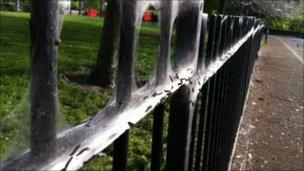Ermine moth larvae in Bradford's Shipley Hall Fields
- Published

Large webs cover some of the park's railings
A Yorkshire urban park has been infested with thousands of caterpillars, stripping 15 trees of all their leaves.
The caterpillars have been identified as Ermine moth larvae and the normally busy Shipley Hall Fields in Bradford is now empty of people.
The larvae have formed large communal webs covering railings and tree trunks in the small park at Frizinghall.
The infestation is not dangerous, but has been caused by recent warm weather.
The larvae are about an inch long.
Rizwan Malik, a Bradford councillor, said: "It's not a serious situation but obviously is distressing.
"I'd like this to be resolved as soon as possible so at least the park can be used again."
Birds and hedgehogs
Dennis Shipway, Bradford Council's pest control manager, said: "We are going to let nature run its course because the Ermine moth larvae is harmless.
"If we were to spray insecticide it could damage the environment more and pose a risk to residents.
"The trees have been stripped of their leaves and bark, but it is too early to say what will happen to them."
The park contains around 40 trees - 15 have been stripped completely bare.
Leaving the larvae to nature will provide a bounty for the local birds and hedgehogs.
All moths start life as a caterpillar, form a pupa, then emerge as a winged adult.
Over 2,400 species of moth have been recorded in the British Isles.